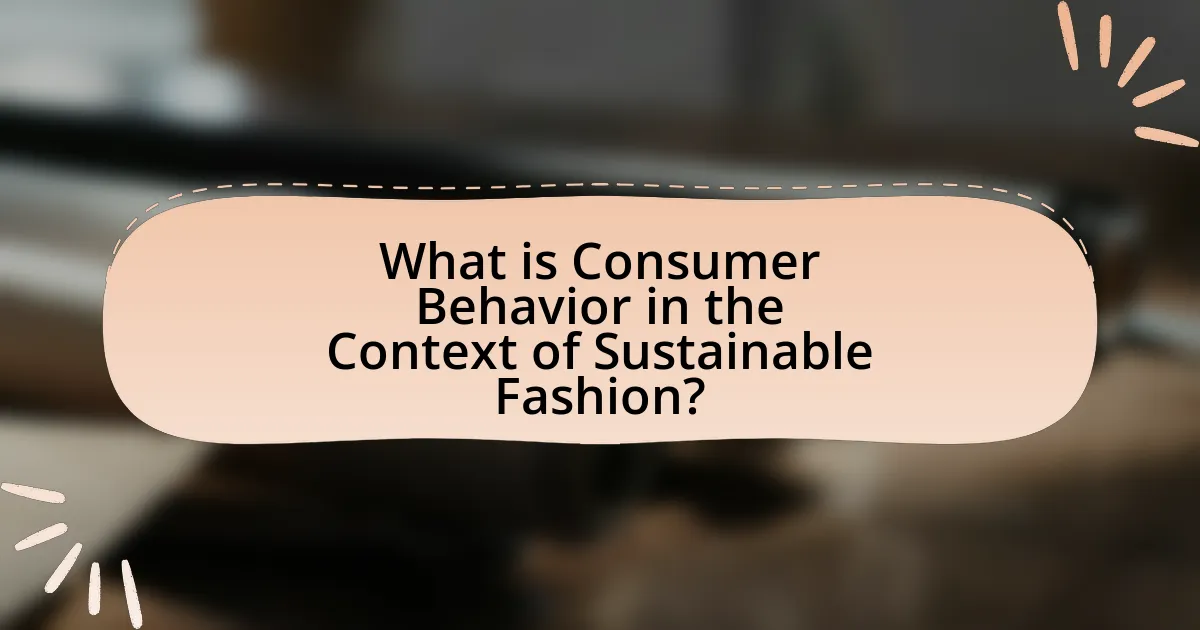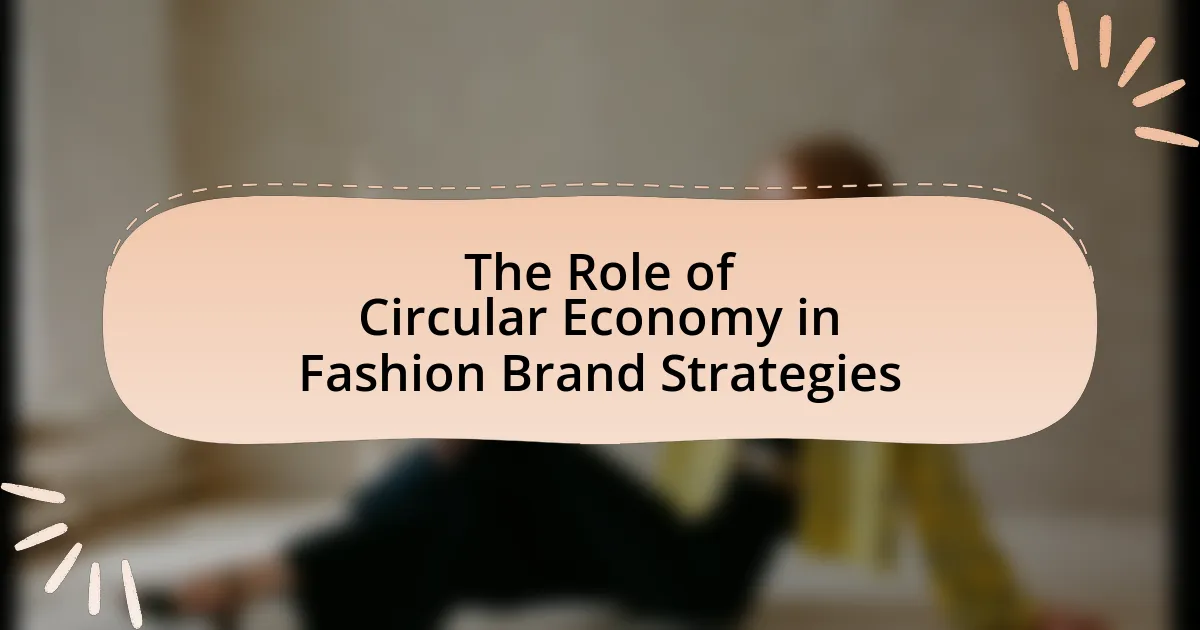Consumer behavior in sustainable fashion reflects the purchasing decisions of individuals who prioritize environmentally friendly and ethically produced clothing. Key factors influencing this behavior include awareness of environmental issues, social responsibility, and the desire for transparency in the fashion supply chain. Research indicates that a significant portion of consumers, particularly Millennials and Generation Z, are willing to pay more for sustainable brands, driving trends towards eco-friendly materials and ethical practices. The article explores how consumer values shape sustainable fashion choices, the impact of demographic factors, and the challenges faced by consumers in making sustainable purchases, while also highlighting the role of brands in facilitating informed decision-making.

What is Consumer Behavior in the Context of Sustainable Fashion?
Consumer behavior in the context of sustainable fashion refers to the purchasing decisions and preferences of consumers that prioritize environmentally friendly and ethically produced clothing. This behavior is influenced by factors such as awareness of environmental issues, social responsibility, and the desire for transparency in the fashion supply chain. Research indicates that 66% of global consumers are willing to pay more for sustainable brands, highlighting a significant shift towards eco-conscious purchasing habits. Additionally, a study by McKinsey & Company found that 67% of consumers consider sustainability when making fashion purchases, demonstrating that consumer behavior is increasingly aligned with sustainable practices in the fashion industry.
How do consumer values influence sustainable fashion choices?
Consumer values significantly influence sustainable fashion choices by driving demand for ethical and environmentally friendly products. When consumers prioritize sustainability, they tend to favor brands that demonstrate transparency, ethical sourcing, and eco-friendly practices. Research indicates that 66% of global consumers are willing to pay more for sustainable brands, highlighting a strong correlation between consumer values and purchasing behavior. This shift in values encourages fashion companies to adopt sustainable practices, as they seek to align with the preferences of their target market.
What specific values drive consumers towards sustainability?
Consumers are driven towards sustainability by values such as environmental responsibility, social equity, and personal health. Environmental responsibility reflects a commitment to reducing ecological impact, as evidenced by a 2021 survey indicating that 66% of global consumers are willing to pay more for sustainable brands. Social equity emphasizes fair labor practices and community support, with 73% of millennials stating they prefer brands that promote social justice. Personal health concerns also play a role, as consumers increasingly seek products that are free from harmful chemicals, aligning with a growing awareness of the health implications of unsustainable practices. These values collectively influence purchasing decisions, steering consumers towards brands that align with their ethical beliefs.
How do these values manifest in purchasing decisions?
Values manifest in purchasing decisions through consumers prioritizing sustainability, ethical sourcing, and social responsibility. For instance, a study by Nielsen found that 66% of global consumers are willing to pay more for sustainable brands, indicating a direct correlation between values and purchasing behavior. Additionally, consumers increasingly research brands’ environmental practices before making purchases, demonstrating that values significantly influence their choices in the fashion industry.
Why is understanding consumer behavior important for sustainable fashion brands?
Understanding consumer behavior is crucial for sustainable fashion brands because it directly influences purchasing decisions and brand loyalty. By analyzing consumer preferences, motivations, and values, sustainable fashion brands can tailor their products and marketing strategies to align with the growing demand for ethical and eco-friendly practices. Research indicates that 66% of global consumers are willing to pay more for sustainable brands, highlighting the importance of understanding what drives this willingness. Additionally, insights into consumer behavior can help brands identify trends, optimize supply chains, and enhance customer engagement, ultimately leading to increased sales and a stronger market position in the competitive fashion industry.
How can brands leverage consumer insights to promote sustainability?
Brands can leverage consumer insights to promote sustainability by analyzing purchasing behaviors and preferences that prioritize eco-friendly products. By utilizing data analytics, brands can identify trends indicating a growing consumer demand for sustainable options, such as organic materials or ethical sourcing. For instance, a study by McKinsey & Company found that 67% of consumers consider the use of sustainable materials important when making purchasing decisions. This insight allows brands to tailor their marketing strategies, product development, and supply chain practices to align with consumer values, thereby enhancing brand loyalty and driving sales in the sustainable fashion sector.
What role does consumer feedback play in shaping sustainable practices?
Consumer feedback plays a crucial role in shaping sustainable practices by influencing companies to adopt environmentally friendly methods. When consumers express preferences for sustainable products, businesses respond by integrating eco-friendly materials, reducing waste, and improving supply chain transparency. For instance, a survey by McKinsey & Company found that 67% of consumers consider sustainability when making purchasing decisions, prompting brands to prioritize sustainable practices to meet market demand. This feedback loop not only drives innovation but also encourages companies to communicate their sustainability efforts, further aligning their practices with consumer values.

How are Shoppers Driving Sustainable Fashion Trends?
Shoppers are driving sustainable fashion trends by increasingly prioritizing eco-friendly products and ethical practices in their purchasing decisions. This shift is evidenced by a 2021 survey from McKinsey & Company, which found that 67% of consumers consider the use of sustainable materials important when buying clothing. Additionally, the rise of social media platforms has amplified awareness of sustainability issues, leading consumers to demand transparency from brands regarding their environmental impact. As a result, many fashion retailers are adapting their strategies to meet these consumer expectations, incorporating sustainable materials and ethical labor practices into their supply chains.
What trends are emerging in sustainable fashion due to consumer behavior?
Emerging trends in sustainable fashion due to consumer behavior include increased demand for transparency, a preference for eco-friendly materials, and a rise in second-hand shopping. Consumers are increasingly seeking brands that provide clear information about their supply chains and production processes, reflecting a desire for ethical practices. Additionally, the popularity of organic cotton, recycled fabrics, and biodegradable materials is growing as shoppers prioritize sustainability in their purchasing decisions. The second-hand market is also expanding, with platforms for resale and rental gaining traction, indicating a shift towards circular fashion practices. These trends are supported by research showing that 66% of global consumers are willing to pay more for sustainable brands, highlighting the significant impact of consumer preferences on the fashion industry.
How do social media and influencers impact sustainable fashion trends?
Social media and influencers significantly shape sustainable fashion trends by amplifying awareness and promoting eco-friendly brands. Influencers leverage their platforms to showcase sustainable practices, educate followers on environmental issues, and endorse brands that prioritize sustainability. For instance, a study by the Fashion Institute of Technology found that 70% of consumers are influenced by social media when making fashion purchases, with many specifically seeking out sustainable options. This trend is further supported by the rise of hashtags like #SustainableFashion, which have garnered millions of posts, creating a community focused on eco-conscious choices.
What role do ethical considerations play in these trends?
Ethical considerations significantly influence sustainable fashion trends by shaping consumer preferences and purchasing decisions. Consumers increasingly prioritize brands that demonstrate social responsibility, environmental stewardship, and ethical labor practices. For instance, a 2021 survey by McKinsey & Company found that 67% of consumers consider sustainability when making fashion purchases, indicating a strong correlation between ethical considerations and consumer behavior. This shift compels brands to adopt transparent supply chains and sustainable practices to meet consumer demand, ultimately driving the growth of the sustainable fashion market.
How do demographic factors influence sustainable fashion purchasing?
Demographic factors significantly influence sustainable fashion purchasing by shaping consumer values, preferences, and purchasing power. For instance, younger consumers, particularly Millennials and Generation Z, tend to prioritize sustainability and ethical practices in their buying decisions, with studies indicating that 73% of Millennials are willing to pay more for sustainable products. Additionally, income levels affect purchasing behavior; higher-income individuals often have more disposable income to spend on sustainable fashion brands, which typically carry a premium price. Furthermore, education level correlates with awareness of environmental issues, leading more educated consumers to choose sustainable options. Research from the Global Fashion Agenda highlights that demographic shifts, such as increasing urbanization and changing family structures, also play a role in how sustainability is perceived and acted upon in fashion purchasing.
What differences exist between generations in their approach to sustainable fashion?
Younger generations, particularly Millennials and Gen Z, prioritize sustainability in fashion significantly more than older generations like Baby Boomers and Generation X. Research indicates that 73% of Millennials are willing to pay more for sustainable products, while only 34% of Baby Boomers express similar sentiments. Additionally, younger consumers actively seek brands that demonstrate ethical practices and transparency, with 62% of Gen Z stating they prefer brands that are environmentally friendly. In contrast, older generations often focus more on price and brand loyalty, showing less engagement with sustainability initiatives. This generational divide highlights a shift in consumer values, where younger shoppers are driving the demand for sustainable fashion through their purchasing decisions.
How does income level affect consumer choices in sustainable fashion?
Income level significantly influences consumer choices in sustainable fashion, as higher income typically allows for greater access to premium sustainable products. Consumers with higher disposable income are more likely to prioritize ethical brands and invest in quality, eco-friendly materials, as they can afford the often higher price points associated with sustainable fashion. For instance, a study by McKinsey & Company in 2021 found that 66% of consumers with an annual income above $100,000 expressed a willingness to pay more for sustainable products compared to only 33% of those earning less than $50,000. This disparity highlights how income level directly correlates with the likelihood of purchasing sustainable fashion items, as wealthier consumers can more easily align their purchasing decisions with their values regarding sustainability.

What Challenges Do Consumers Face in Sustainable Fashion Shopping?
Consumers face several challenges in sustainable fashion shopping, primarily including higher prices, limited availability, and lack of information. Higher prices often deter consumers, as sustainable brands typically incur greater production costs due to ethical sourcing and environmentally friendly materials. Limited availability poses another challenge, as sustainable options may not be as widely accessible in mainstream retail outlets, making it difficult for consumers to find desired products. Additionally, a lack of clear information regarding the sustainability claims of brands can confuse consumers, leading to skepticism about the authenticity of eco-friendly practices. According to a 2021 survey by McKinsey & Company, 66% of consumers expressed concern about the environmental impact of their purchases, yet many reported feeling overwhelmed by the choices and information available, highlighting the need for clearer guidance in sustainable fashion shopping.
What barriers prevent consumers from choosing sustainable fashion options?
Barriers preventing consumers from choosing sustainable fashion options include higher costs, limited availability, and lack of awareness. Higher costs deter consumers as sustainable fashion items often have a premium price due to ethical production practices and quality materials. Limited availability restricts access, as many sustainable brands are not widely distributed in mainstream retail outlets. Additionally, a lack of awareness about the environmental impact of fast fashion and the benefits of sustainable alternatives contributes to consumer hesitation. According to a 2021 survey by McKinsey & Company, 66% of consumers expressed a willingness to pay more for sustainable products, but only 27% actively seek them out, highlighting the gap between intention and action.
How does price sensitivity affect sustainable fashion purchases?
Price sensitivity significantly impacts sustainable fashion purchases by influencing consumers’ willingness to pay a premium for eco-friendly products. Research indicates that many consumers prioritize affordability over sustainability, leading to a preference for lower-priced fast fashion items. A study published in the Journal of Fashion Marketing and Management found that 70% of consumers consider price as a primary factor when making clothing purchases, often at the expense of sustainable options. This price sensitivity can deter consumers from choosing sustainable brands, which typically have higher production costs due to ethical sourcing and environmentally friendly practices. Consequently, brands that aim to promote sustainable fashion must find ways to balance quality and price to attract price-sensitive consumers while maintaining their commitment to sustainability.
What misconceptions exist about sustainable fashion among consumers?
Many consumers mistakenly believe that sustainable fashion is significantly more expensive than conventional fashion. This misconception arises from the perception that eco-friendly materials and ethical production processes inherently lead to higher prices. However, studies indicate that while some sustainable brands may have higher upfront costs, the overall market for sustainable fashion is diversifying, with affordable options emerging. For instance, a report by McKinsey & Company highlights that the sustainable fashion market is expected to grow, leading to increased competition and potentially lower prices over time. Additionally, consumers often think that sustainable fashion lacks variety and style, but many brands now offer a wide range of fashionable options that cater to diverse tastes, proving that sustainability and style can coexist.
How can consumers overcome these challenges?
Consumers can overcome challenges in sustainable fashion by prioritizing education and awareness about eco-friendly brands and practices. By researching and understanding the environmental impact of their purchases, consumers can make informed choices that align with sustainable values. For instance, a study by the Fashion Institute of Technology found that 66% of consumers are willing to pay more for sustainable products, indicating a growing demand for transparency and ethical practices in the fashion industry. Additionally, consumers can support local and sustainable brands, reducing carbon footprints associated with transportation and promoting ethical labor practices. Engaging in second-hand shopping and clothing swaps also helps minimize waste and encourages a circular economy.
What strategies can consumers employ to make informed choices?
Consumers can employ several strategies to make informed choices, particularly in the context of sustainable fashion. First, they can research brands and their sustainability practices by reviewing certifications, such as Fair Trade or Global Organic Textile Standard, which indicate ethical production methods. Additionally, consumers can read product labels to understand the materials used and their environmental impact, as well as seek out transparency reports published by companies that detail their supply chain practices.
Furthermore, engaging with online platforms and communities that focus on sustainable fashion can provide valuable insights and recommendations. According to a 2021 survey by McKinsey & Company, 67% of consumers consider sustainability when making fashion purchases, highlighting the growing importance of informed decision-making in this sector. By utilizing these strategies, consumers can better align their purchases with their values and contribute to more sustainable practices in the fashion industry.
How can brands assist consumers in navigating sustainable options?
Brands can assist consumers in navigating sustainable options by providing clear information about the sustainability of their products. This includes labeling products with certifications such as Fair Trade or organic, which helps consumers make informed choices. Research indicates that 66% of consumers are willing to pay more for sustainable brands, highlighting the demand for transparency in sustainability practices. By offering educational resources, such as guides on sustainable materials and production processes, brands can further empower consumers to understand the impact of their purchases.
What are the best practices for consumers interested in sustainable fashion?
Consumers interested in sustainable fashion should prioritize purchasing from brands that demonstrate transparency in their supply chains and use eco-friendly materials. Research indicates that 66% of consumers are willing to pay more for sustainable brands, highlighting the demand for ethical practices. Additionally, consumers can extend the lifecycle of their clothing by opting for second-hand shopping, which reduces waste and promotes circular fashion. Engaging in clothing swaps and supporting local artisans also contributes to sustainability. By making informed choices, consumers can significantly impact the fashion industry’s environmental footprint.
How can consumers identify truly sustainable brands?
Consumers can identify truly sustainable brands by examining their transparency, certifications, and supply chain practices. Brands that openly share information about their sourcing, production processes, and environmental impact demonstrate a commitment to sustainability. Certifications such as Fair Trade, Global Organic Textile Standard (GOTS), and the Forest Stewardship Council (FSC) provide credible validation of a brand’s sustainable practices. Additionally, brands that prioritize ethical labor practices and use eco-friendly materials, such as organic cotton or recycled polyester, further indicate their sustainability efforts. Research shows that consumers increasingly prefer brands that align with their values, with 66% of global consumers willing to pay more for sustainable brands, according to Nielsen’s Global Corporate Sustainability Report.
What tips can help consumers make more sustainable fashion choices?
Consumers can make more sustainable fashion choices by prioritizing quality over quantity, opting for eco-friendly materials, and supporting ethical brands. Prioritizing quality ensures that garments last longer, reducing the need for frequent replacements, which contributes to less waste. Choosing eco-friendly materials, such as organic cotton or recycled fabrics, minimizes environmental impact during production. Supporting ethical brands that practice fair labor and sustainable sourcing further encourages responsible consumption. According to a 2021 report by McKinsey & Company, sustainable fashion can reduce carbon emissions by up to 30% if consumers shift their purchasing habits towards these practices.




